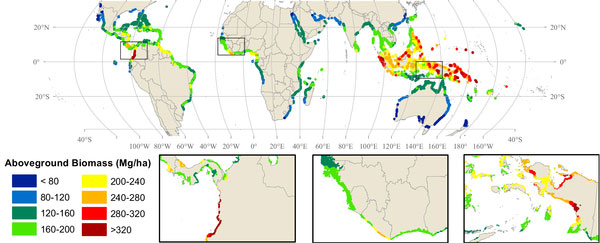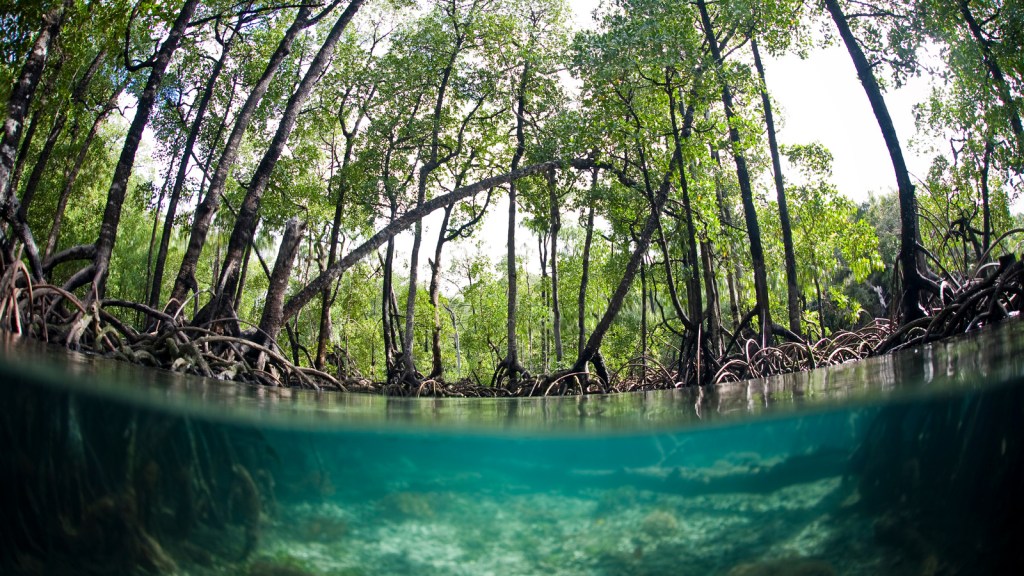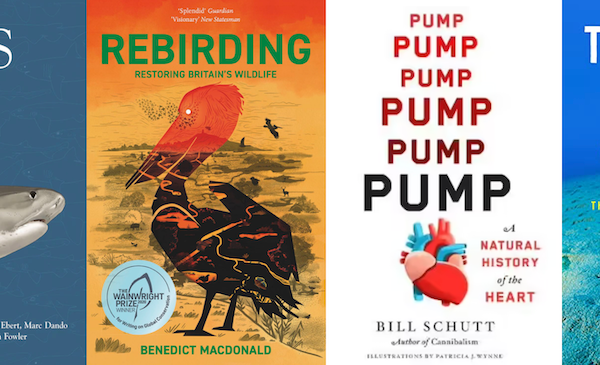My colleagues and I have just published a study in Conservation Letters in which we work out how much carbon there is in the world’s mangrove forests, give or take a bit.
And we mapped it.
And here’s why these findings are tremendously important:
They quantify what some of us in marine conservation have been saying for a decade or more: That mangrove forests are among the most carbon-rich habitats on the planet. That, although they occupy just a fraction of the world’s surface, they pack a punch.
Anyone concerned about preserving nature’s value — carbon sequestration and all the other benefits mangroves provide us — needs to think hard about this.
Because on average, mangroves have double the living biomass of tropical forests overall. This means that if you want to slow carbon emissions, one of the first places you could look would be in the mangroves. Stop an acre of loss here, and you will achieve a much bigger win than in many other areas.
But the average also hides a host of variance. Look at the map here and you’ll see that there’s a tenfold range in above-ground biomass:

So as we make our increasingly bold statements about the importance of mangrove biomass — or indeed around any ecosystem services — it is SO important that we have the numbers to back up our claims.
Until this paper, the best we could in most places was provide a global average number. “A typical mangrove has 152 tons of aboveground biomass per hectare,” we might say.
That doesn’t sound at all convincing whether you are standing at the foot of canopy giant in Berau, Indonesia, or indeed on the margins of straggly community of mangrove shrubs in the desert margins of the Middle East.
To do this new paper, we stood on the shoulders of hundreds of others who have sweated and toiled in the tropical heat of the mangroves, doing the real work of assessing biomass.
We took numbers from 95 studies around the world and built a computer model around the climatic factors that help to drive the variability in biomass from place to place.
It’s a model, of course, and only captures part of reality, but it’s a huge advance. We need this sort of work — both the hard data from the field scientists and the verifiable models of what’s going on.
It means so much more than average numbers. Without it, all our platitudes and pleadings about the value of nature run the risk of sounding hollow.
The map shows the real hotspots for mangrove biomass. The countries of the Coral Triangle lead the way, but the overlap with coral reefs isn’t always neat — it’s the wet muddy coasts of Sumatra, Borneo, and New Guinea that have the very high biomass.
So, too, does an extraordinary stretch of coastline in on the Pacific coast of Colombia and Northern Ecuador. In all these places mangroves are truly breathtaking — gigantic trees with canopies reaching well over 30m high. These are found on wide, still growing deltas where they hold together sediments and add vast amounts of organic nutrients to the soils and the surrounding waters.
When it comes to soils, we’re still struggling with the models a bit, but the story is equally compelling. Most mangrove forests lay down peat — thick, heavy layers of carbon-rich soil that stays waterlogged and doesn’t rot.
There are other important peat forests worldwide, but the microbial processes in those peat forests give off pretty substantial amounts of methane, which is a greenhouse gas in its own right. The saline soils of the mangroves generally prevent this methane production. That gives us a huge extra carbon store in the soil.
But it’s not just a store. Mangroves are celebrated as one of the most productive ecosystems on the planet, and it is believed that about 10% of what they produce also gets sequestered away in the soil.
That word “sequestered” should be music to our ears. In other words, mangroves are natural carbon-scrubbers, taking CO2 out of the atmosphere and packing it away, for millennia or more, in their rich soils.
So if you had a dollar to invest in carbon futures, my strongest advice of all would be to invest in preventing mangrove loss, or even restoration. There’s no magic cure to the challenges of global change – warming, rising seas, worsening storms and ocean acidification – we’ll only ever get there through a combination of interventions. Mangroves aren’t sufficiently widespread to tip the scales, but they give a greater return on investment than many other mitigation efforts.
But on a unit-area basis, it would be hard to think of a more important ecosystem. And that’s before you even start to add up the value for fisheries, timber, tourism, coastal protection and so on.
This work was supervised by Dr. Mark Spalding, the lead author was James Hutchison, a researcher at the University of Cambridge now working with TNC on mangrove fisheries, and the other co-authors were other Cambridge conservation scientists: Andrea Manica, Ruth Swetnam (now at University of Staffordshire) and Andrew Balmford.




Where are your citations? What articles were used for this blog? i really want to know what research was used for this.
There is a link to the paper in Conservation Letters at the beginning of the blog. You can read the original paper here: https://onlinelibrary.wiley.com/doi/full/10.1111/conl.12060
Thanks!
The country is called ColOmbia, not ColUmbia.
Thank you for the correction! We have fixed the typo.
Dear Mark,
Thank you very much for this work.
I used the figure 174 gC per square meter from a paper by Daniel Alonghi
for carbon sequestered per year by mangrove forests. Do you have
a better figure including both above- and below-ground sequestration?
From this it seems that Mangrove forests can sequester about 2.5 times the carbon of
other forest types. Many authors seem to confuse total biomass (sequestration over large time
scales) with annual sequestration rates.
It would be very good if we could grow mangrove forests anywhere, such as in greenhouses, since
the natural environments are limited to certain areas of the world with high humidity and soils that are already rich. Do you know of any successful attempts to grow mangrove forests from scratch?
Thanks,
Chuck
Hi Mark,
Bula Im Sanaila Naqali from Fiji and is the deputy secretary for Fisheries and I like reading your briefs.
The most recent one was on the mangrove as carbon sinks which we in Fiji have great potential to contribute to sequestration and eventually slow down the emission of CO2 into the atmosphere.
I would like to ask you to share your view on how best we (FISHERIES) can benefit from ”THE BLUE ECONOMY” concept/principle to gain in identifying alternatives for economic development means if fishing from the wild and offshore is over-fished etc.
Bula Sanaila
The role of mangroves in enhancing fisheries is well known, but we still lack the fine details to persuade some managers to act on this knowledge. Mangroves are critical for some species, and for the breeding or juvenile phases of others – securing fisheries for these species can mean maintaining or enhancing mangroves alongside any direct fisheries management.
We are currently working on a refined model which might help people to quantify the value of particular mangroves, but in the interim you can look at these two publications:
https://goo.gl/2JB9gs and https://goo.gl/ea214H
or a more complete report here:
https://www.wetlands.org/publications/the-role-of-mangroves-in-fisheries-enhancement/
While you can actually explore the initial heat map here:
http://maps.oceanwealth.org/
What will follow in 6 months or so will be a much better model…and I expect another blog!
Thanks
Mark Spalding
I am Tanzanian living close and next to mangroves forest in dar es salaam cost.the area accupir area ,1000 square metres.i was thinking to invest honey and fishing farming in it. I invite partners who we can work together.
Thanks
Dr Evarist Temu
Great map!
What is the process by which mangroves work as carbon bank?
Hi shinigami, Like other trees, mangroves “breathe” carbon dioxide from the air and use it to grow. Their biomass contains carbon, as long as the tree is alive, that carbon is sequestered from the environment. What makes mangroves unique is that their roots also hold together moist soil or peat – “thick, heavy layers of carbon-rich soil that stays waterlogged and doesn’t rot” – as the post mentions. The “doesn’t rot” part is important – it means that organic matter (also containing carbon) in those soils (from sources like falling leaves, dead branches, and more) is also sequestered there for long periods of time. You might be interested in this article in Nature Geoscience for more information: http://www.nature.com/ngeo/journal/v4/n5/full/ngeo1123.html?words=Breivik
Good evening everyone…
I would like to share with colleagues about our work in degraded mangrove forest on the north coast of Brazil and eastern Amazon. We are one year collecting CO2 data, H2O and energy flows in a micrometeorological tower (LBA Program – Experiment Great atmosphere biosphere scale in the Amazon) 12m in a mangrove swamp which has a very strong degradation process in the last 10 years. Watching your paper (very interesting), we note that has nothing related to mangroves in the eastern Amazon. Put at the disposal our work that have not been published to interact future work.
Prof. Dr. Adriano Sousa (LBA – Belém, Pará-Brazil).
We analyze ecosystem function of mangrove ecosystem as blue carbon source and biofilter for the coastal zone started from 2014 until now, and to be continued on blue carbon dynamics and resistance of mangroves from sea level rise and heavy metal pollutants in the coral triangle eco-region, southeast sulawesi, Indonesia.
Dr. Kangkuso Analuddin
Associate professor on wetlands ecology
Halu Oleo University, Indonesia
Excellent job